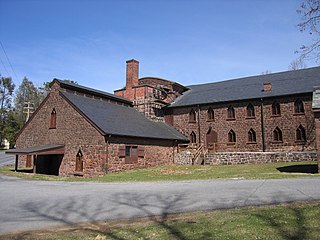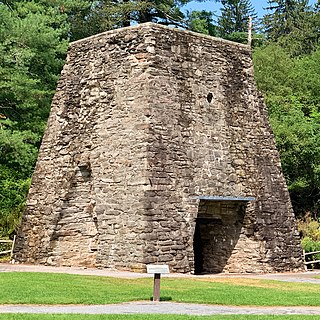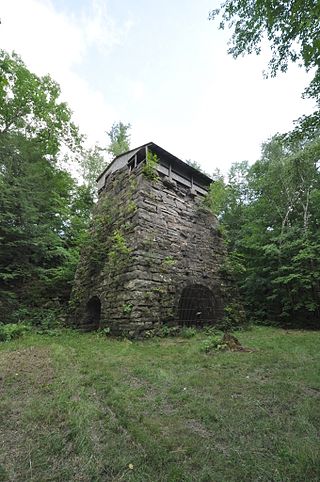
Perry County is a county located in the U.S. state of Tennessee. As of the 2020 census, the population was 8,366, with an average population density of 20.2 persons per square mile it is the least densely populated county in Tennessee. Its county seat and largest town is Linden. It is named after American naval commander and War of 1812 hero Oliver Hazard Perry.

Anthracite iron or anthracite pig iron is the substance created by the smelting together of anthracite coal and iron ore, that is using anthracite coal instead of charcoal to smelt iron ores—and was an important historic advance in the late-1830s, enabling a great acceleration of the industrial revolution in Europe and North America.

A bloomery is a type of metallurgical furnace once used widely for smelting iron from its oxides. The bloomery was the earliest form of smelter capable of smelting iron. Bloomeries produce a porous mass of iron and slag called a bloom. The mix of slag and iron in the bloom, termed sponge iron, is usually consolidated and further forged into wrought iron. Blast furnaces, which produce pig iron, have largely superseded bloomeries.

The Lehigh Crane Iron Company was a major ironmaking firm in the Lehigh Valley from its founding in 1839 until its sale in 1899. It was founded under the patronage of Josiah White and Erskine Hazard, and financed by their Lehigh Coal & Navigation Company, which hoped to promote the then-novel technique of smelting iron ore with anthracite coal. This was an important cost and energy savings technique, since either an expensive charcoaling nor coke producing process and transport costs was totally eliminated so produced a great acceleration in the underpinnings of the American industrial revolution.

Iron plantations were rural localities emergent in the late-18th century and predominant in the early-19th century that specialized in the production of pig iron and bar iron from crude iron ore. Such plantations derive their name from two sources: first, because they were nearly self-sufficient communities despite an almost singular focus on the production of iron to be sold on the market, and second, because of the large swaths of forest and land necessary to provide charcoal fuel and ore for their operations. The first plantations stretched across the Northeast, Midwest, and Southern United States, “the chief charcoal iron producing states [being] Pennsylvania, Ohio, New York, Virginia, Connecticut, Maryland, Missouri, Tennessee, and Kentucky." Many produced raw materials used in the American Revolution or to be exported to England. Throughout the remainder of the 19th century, however, only locations that adopted new technologies first introduced by competing coal- and coke-powered smelters in the rapidly industrializing field persisted.

Onota was a village in the Upper Peninsula of the U.S. state of Michigan. It was located on the Grand Island Bay of Lake Superior near the present-day community of Christmas about five miles (8 km) west of Munising in Alger County. The site of Onota is within the Bay Furnace Campground and Picnic Area of the Hiawatha National Forest. The remains of Bay Furnace, a blast furnace used for smelting iron, is the only extant remnant of the town. Bay Furnace was listed on the National Register of Historic Places and designated a Michigan State Historic Site in 1971.

Cornwall Iron Furnace is a designated National Historic Landmark that is administered by the Pennsylvania Historical and Museum Commission in Cornwall, Lebanon County, Pennsylvania in the United States. The furnace was a leading Pennsylvania iron producer from 1742 until it was shut down in 1883. The furnaces, support buildings and surrounding community have been preserved as a historical site and museum, providing a glimpse into Lebanon County's industrial past. The site is the only intact charcoal-burning iron blast furnace in its original plantation in the western hemisphere. Established by Peter Grubb in 1742, Cornwall Furnace was operated during the Revolution by his sons Curtis and Peter Jr. who were major arms providers to George Washington. Robert Coleman acquired Cornwall Furnace after the Revolution and became Pennsylvania's first millionaire. Ownership of the furnace and its surroundings was transferred to the Commonwealth of Pennsylvania in 1932.

Cornwall Furnace is located near Cedar Bluff, Alabama in Cherokee County. It was built by the Noble Brothers to supply iron products to the Confederate States of America during the American Civil War.

The Oregon Iron Company was an iron smelting company located in what is now Lake Oswego, Oregon. The company was established in 1865, and in 1867, became the first company west of the Rocky Mountains in the United States to smelt iron. The company failed after a few years, but was reorganized as the Oswego Iron Company in 1878, and again as the Oregon Iron and Steel Company in 1883. With the addition of a larger furnace, the last incarnation of the company prospered, reaching peak production in 1890. By 1894, however, pressure from cheaper imported iron combined with the effects of the Panic of 1893 forced the company to close its smelter. The company continued to operate a pipe foundry until 1928, and until the early 1960s, existed as a land management company, selling its real estate holdings which expanded the city of Lake Oswego.

The Pine Grove Iron Works was a southcentral Pennsylvania smelting facility during the Industrial Revolution. The works is notable for remaining structures that are historical visitor attractions of Pine Grove Furnace State Park, including the furnace stack of the Pine Grove Furnace. The site was listed on the National Register of Historic Places on April 13, 1977 for its significance in architecture and industry. It includes seven contributing buildings, two structures, fourteen sites, and two objects.

The Neabsco Iron Works was located in Woodbridge, Virginia, US. It was situated on 5,000 acres (2,000 ha) by the Neabsco Creek.
The Cedar Creek Furnace is a former blast furnace site near Russellville in Franklin County, Alabama. It was the first iron ore furnace in Alabama, preceding an industry that would come to dominate the state's economy in the late 19th and early 20th century.
Clarksville Iron Furnace was a charcoal iron furnace in Unicoi County, Tennessee, built in 1833 and operated until 1844. Its ruins are in Cherokee National Forest and are listed on the National Register of Historic Places.

Adolphus William Copper Smelter is a heritage-listed former copper smelter and associated mining camp at Westwood and Oakey Creek in Rockhampton Region, Queensland, Australia. It was built in 1874. It was added to the Queensland Heritage Register on 13 May 2011.

The Furnace Grove Historic District encompasses the remains of a historic 19th-century iron processing facility near Bennington, Vermont. Located on the north side of Vermont Route 9 east of the town center, its production peaked in the 1830s, and was afterward converted into a gentleman's farm. Surviving elements of its past include the remains of iron smelting furnaces, housing, and agricultural outbuildings. The district was listed on the National Register of Historic Places in 1997.

The Forest Dale Iron Furnace was a 19th-century iron smelting facility in Brandon, Vermont. Located off Vermont Route 73 east of the village of Forest Dale, it operated between 1810 and 1855, closing due to competition from higher quality and more efficient furnaces. Now reduced to archaeological ruins and the remains of its main furnace stack, it was listed on the National Register of Historic Places in 1974. The site is marked by a historic marker on Vermont 73.

The Bogolong iron mine and blast furnace is an abandoned iron mining and smelting site, near Bookham, New South Wales, Australia. Located in an area known best for sheep grazing and wool, it has been called Australia's 'forgotten furnace'. In 1874, the blast furnace produced a small amount of pig iron—sufficient to allow its testing—that was smelted from iron ore mined nearby. Plans to operate commercially did not eventuate. It is significant as one of the only three remaining ruins of 19th-Century iron-smelting blast furnaces in Australia, and the only one in New South Wales.

The British and Tasmanian Charcoal Iron Company (BTCIC) was an iron mining and smelting company that operated from 1874 to 1878 in Northern Tasmania, Australia. It was formed by floating the operations of a private company, the Tasmanian Charcoal Iron Company that operated between 1871 and 1874.

The Ilfracombe Iron Company (I.I.C.) was an iron mining and smelting company that operated in Northern Tasmania in 1873 and 1874.

The Fitchburg Furnace is a historic iron furnace located in the Daniel Boone National Forest in Estill County, KY.




















